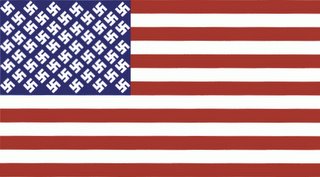While some are speculating over U.S. Iran relations and the potential for conflict over Irans nuclear power options, the reality is that the U.S. is eyeing Syria for its next expansionist occupation.
The set up is clear, the U.N. has condemned Syria for involvement in Lebanon, the U.S. is talking about porous borders allowing foreign terrorists to move into Iraq from Syria, and has already had border town skirmishes in the last month. The U.S. has moved active forces out of Baghdad onto the Syrian border. As Le Monde Diplomatique poiunts out in a feature article this is a dangerous situation being percipitated in the Middle East not only by the U.S. but by the U.N. investigation into the death of leading Lebonanese politicians and journalists and the involvement of the Syrian Secret Service and factions of the military.
Syria: a concerted offensive All eyes are on Syria as it stands accused of being behind the murder of the former Lebanese prime minister Rafik Hariri. Even before the UN commission of inquiry was completed, the US was planning - with France - a concerted offensive against the Syrian regime. But destabilising President Bashar al-Assad could lead to regional chaos, given the fragility of Lebanon and near civil war in Iraq.
By Alain Gresh
“IN ORDER to facilitate the action of the liberation forces, to reduce the capabilities of the Syrian regime to organise and direct its military actions, to keep losses and destruction to a minimum, and to bring about the desired results in the shortest possible time, a special effort should be made to eliminate certain key individuals. Their removal should be accomplished early in the course of the uprising and intervention.” For that, Damascus must be “made to appear as the sponsor of plots, sabotage and violence directed against neighbouring governments”.
The CIA and its British counterpart would “use their capabilities in both the psychological and the action fields to increase tension”. The overthrow of the regime would also mean the financing of a committee for a free Syria and the arming of different political factions to give them paramilitary capabilities.
All this comes from a document dating from autumn 1957 that was recently discovered by a researcher. The document was approved by the United States president, Dwight Eisenhower, and the British prime minister, Harold Macmillan.
At that time the Middle East was already regarded, simplistically, as a place for East-West confrontation. The US and British governments saw the Syrian regime - which was then genuinely liberal and democratic, if nationalist - as no more than a Soviet pawn. That meant it needed to be got rid of and its leaders killed. However, a few months later, in January 1958, the Syrians went to Gamal Abdel Nasser to ask for Syria’s unification with Egypt. From the moment the new United Arab Republic was established, its relations with Moscow grew strained, and so the West’s subversive plans were dropped.
The world has since changed. The war against terrorism has replaced the war against communism. But the US vision remains as simplistic as it was then: whoever is not with us is against us, says George Bush. At the time of a “third world war”, of US efforts to crush the Iraqi resistance and beat the Arab world into submission, the reluctance of the Syrian regime to bend to Washington’s will can no longer be tolerated.
Are we none the less heading for a racheting up of tension? A sanctions regime against Syria would penalise its population first, as it did in Iraq. Closing Syria’s borders would create problems with its neighbours, starting with Lebanon. And the fall of the Syrian regime would only extend the regional chaos created by the US military intervention in Iraq and the ensuing occupation.
The Washington Post had this to say: “The planning process, according to the internal documents, includes courses of action for cross-border operations to seal the Syria-Iraq border and destroy safe havens supporting the Iraqi insurgency, attacks on Syrian weapons of mass destruction infrastructure supporting the development of biological and chemical weapons, and attacks on the regime of Syria’s president, Bashar al-Assad”. The paper’s military commentator, who revealed these American plans, did not say whether, as in 1957, the assassination of Syrian leaders was part of the plans.
Tags
Iraq
USA
Syria
War
Lebanon





